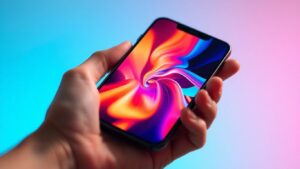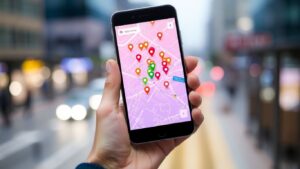- About us
- Services
- E-Commerce Development
- White Label Marketing
- Digital Marketing
- Mobile App Development
- Other Services
-


In this day and age, pretty much everyone has a smartphone. They’re always in our pockets or on our laps, right? Because of this, businesses really need to pay attention to how they reach people through these devices. If your company isn’t thinking about mobile marketing, you’re probably missing out on a huge opportunity to connect with customers. It’s not just about having a website anymore; it’s about meeting people where they are, and most of the time, that’s on their phones. This article will break down why mobile marketing is so important for your overall digital strategy and what you can do to make it work for you.

It’s pretty hard to ignore how much we all use our phones these days. Seriously, think about your own day. From the moment you wake up, chances are your phone is the first thing you reach for, and it’s probably the last thing you see before you fall asleep. This isn’t just a trend; it’s a fundamental shift in how we live, work, and play. Our smartphones have become extensions of ourselves, constantly connected and always within reach. This constant presence means brands have an unprecedented opportunity to connect with people in ways that were unimaginable just a decade ago. It’s not just about sending out a generic ad anymore; it’s about being there, right when someone might need you, on the device they use for everything else.
Let’s face it, smartphones are everywhere. We use them for checking the weather, catching up with friends, finding directions, and yes, shopping. The numbers back this up: the average person in the US spends over 4 hours a day on their phone. That’s a huge chunk of time! This isn’t just idle browsing; people are actively searching for information, making decisions, and even buying things directly from their phones. It’s become the go-to tool for discovery, whether you’re trying to settle a bet about an actor’s name or researching the best local pizza place.
Because our phones are always with us, they offer a direct line to consumers. This constant connectivity means brands can engage with people in real-time. Think about getting a notification about a sale when you’re walking past a store, or receiving a helpful tip related to a product you recently bought. This kind of timely interaction feels less like an interruption and more like a helpful nudge. It’s about being present and relevant in the moments that matter to your audience, making your brand a familiar and trusted part of their daily digital lives.
Today’s consumers expect things to work smoothly on their phones. They’re used to quick answers, easy navigation, and personalized experiences. If your website or app is clunky on a mobile device, they’re likely to just leave and find someone who does it better. This
Think about how often you check your phone. It’s practically an extension of ourselves these days, right? This constant connection gives brands a unique chance to build real relationships. Instead of shouting into the void, mobile marketing lets you talk with people. You can send a quick text about a sale that’s just for them, or a notification about a new product they’ve shown interest in. It’s about making each person feel seen and valued. This personal touch is what turns a casual browser into a loyal customer. It’s not just about selling; it’s about being there for your customers in a way that feels natural and helpful.
Mobile devices are in our hands when we’re making decisions, big or small. Whether someone is looking up reviews while standing in a store or comparing prices on the go, your mobile marketing efforts can directly influence their choices. A well-timed offer, a clear call to action on a mobile-friendly page, or even a simple reminder can be the nudge someone needs to click ‘buy’. It’s about being present at the right moment with the right message. This immediacy is powerful.
Mobile marketing puts your brand directly into the customer’s pocket, making it easier than ever to influence their buying journey from discovery to decision.
Every interaction a customer has with your brand on their phone matters. This includes everything from how easy your website is to use on a small screen to how helpful your app is. Making these touchpoints smooth and pleasant is key. Think about:
When these mobile interactions are good, customers feel good about your brand. It builds trust and encourages them to come back. It’s about making their lives a little easier, one tap at a time.
Think about it: your phone is practically glued to your hand, right? That means when you send out marketing messages, they’re not just going into the void; they’re landing right in the pocket of someone who’s probably already thinking about what you offer. This is where precision targeting and location-based relevance really shine. It’s about getting the right message to the right person at the exact moment they’re most likely to care.
This is a game-changer, especially for businesses that rely on foot traffic. Imagine someone walking past your coffee shop. If your system can detect they’re nearby, you could send them a quick notification: ‘Hey, warm up with a latte! 10% off for the next hour.’ It’s immediate, it’s relevant, and it taps into that impulse to treat yourself. Tools like geofencing let you set up virtual boundaries around your store or event. Anyone who crosses that line gets a special message. It’s like having a digital megaphone that only talks to people who are right there.
It’s not just about where people are, but when they need something. If someone is searching for ‘best pizza near me’ on their phone, that’s a prime moment. Your marketing should be ready to pop up with a delicious-looking ad or a special offer from your restaurant. This means understanding user behavior and anticipating their needs. Think about someone planning a weekend trip. They might be looking for hotel deals on Friday afternoon. Sending them a targeted ad for a hotel package at that exact time is way more effective than a random ad they see on Monday morning.
This is where things get really smart. By looking at what people do on their phones – what they search for, what apps they use, what they click on – you can build a pretty good picture of their interests. Let’s say someone frequently searches for hiking gear. You can then show them ads for new boots or backpacks. It feels less like an interruption and more like helpful suggestions. This kind of personalization builds trust because it shows you’re paying attention and trying to be genuinely useful, not just shouting into the crowd. It makes your marketing feel less like advertising and more like a helpful friend.

Think about how often you pull out your phone each day. It’s probably a lot, right? That’s exactly why mobile marketing is so powerful for getting your brand in front of people. Your customers are already on their phones, so that’s where you need to be too. It’s not just about reaching a few people; it’s about tapping into a massive audience that’s constantly connected.
It’s hard to overstate just how many people use mobile devices. From teenagers to grandparents, almost everyone has a smartphone these days. This means your potential customer base is huge, and mobile marketing lets you connect with them wherever they are. Whether they’re commuting, relaxing at home, or out and about, your message can reach them.
More and more, people are using their phones to go online. Websites, apps, and social media are all accessed primarily through mobile devices. If your business isn’t optimized for mobile, you’re missing out on the majority of internet users. It’s like having a shop on a busy street but keeping the doors locked.
Mobile marketing isn’t just for one age group or type of person. It’s incredibly versatile. You can reach young adults scrolling through social media, busy parents looking for quick solutions, or older individuals staying connected with family. The key is understanding where different groups spend their time online and tailoring your approach.
Here’s a quick look at how mobile usage breaks down:
| Demographic Group | Estimated Mobile Usage |
|---|---|
| Gen Z (16-25) | 95%+ |
| Millennials (26-40) | 93%+ |
| Gen X (41-56) | 88%+ |
| Baby Boomers (57-75) | 70%+ |
Reaching people on their phones means meeting them where they are, making it easier for them to discover and interact with your brand. It’s about being present and accessible in their everyday lives.
This widespread accessibility means your marketing efforts can have a much bigger impact. You’re not limited by geography or specific times of day. Mobile puts your brand right into the hands of potential customers, making it easier than ever to get noticed.
So, you’ve got your digital strategy humming along, but are you really talking to your customers where they actually are? Most folks are glued to their phones these days, so ignoring mobile is like setting up shop on a deserted island. It’s not just about having a website; it’s about meeting people on their favorite device. This is where smart mobile marketing comes in, turning those everyday interactions into opportunities for your brand. Let’s look at some tried-and-true ways to make your mobile efforts count.
Think about the last time you ignored a text message. Hard to remember, right? SMS marketing is like that old reliable friend – it gets noticed. You can send out quick updates, special offers, or even appointment reminders. It’s direct, personal, and people tend to check their texts out of habit. Push notifications are similar, but they live within apps. They’re great for grabbing attention when someone might be thinking about your product or service. Imagine a notification popping up saying that item you left in your cart is now on sale. Pretty effective, huh?
The trick with both SMS and push notifications is timing and relevance. Bombarding people with messages they don’t want or need will just get you ignored, or worse, blocked. It’s all about sending the right message, to the right person, at the right moment.
If you have your own app, you’ve got a direct line to your most engaged customers. You can use banners, special messages, or even full-screen ads right within your app to promote products or services. But what if you don’t have an app? That’s where your mobile website comes in. It needs to be fast, easy to use on a small screen, and look good on any phone. People are researching and buying on their phones more than ever, so your mobile site is often the first, and sometimes only, impression you make. Making sure it’s top-notch is non-negotiable.
| Tactic | Best For |
|---|---|
| In-App Banners | Quick promotions, feature highlights |
| In-App Messages | Personalized offers, customer support |
| Mobile Website | General information, e-commerce, lead gen |
| App Store Listings | Discoverability, downloads, user acquisition |
Let’s face it, most social media scrolling happens on phones. So, if you’re not active and engaging on social media with a mobile-first approach, you’re missing a huge chunk of the conversation. It’s not just about posting; it’s about interacting. Respond to comments, run mobile-specific ad campaigns, and create content that looks great on a small screen. Social media is a fantastic place to build relationships, answer questions, and keep your brand front-of-mind as people casually browse their feeds throughout the day.
So, you’ve put a lot of effort into your mobile marketing campaigns. That’s great! But how do you know if it’s actually working? This is where measuring and optimizing come in. It’s not enough to just launch something and hope for the best. You need to look at the numbers and make smart adjustments. Think of it like tuning up a car; you want it running as smoothly and efficiently as possible.
This is where you really get to see what’s happening. Mobile analytics tools are your best friend here. They show you how people are interacting with your mobile ads, your website on their phones, or even your app. You can see things like:
Looking at this data isn’t just about seeing numbers; it’s about understanding behavior. It helps you figure out what’s working and what’s not, so you can make better choices next time.
Google and other search engines are really focused on how your site works on mobile devices now. This is called mobile-first indexing. Basically, they look at the mobile version of your website first when deciding how to rank it. So, if your mobile site is slow, hard to read, or doesn’t work right, your search rankings will suffer, even if your desktop site is perfect. Making sure your website is responsive, loads quickly on phones, and is easy to navigate is super important for showing up in search results when people are looking for you on their phones.
Once you have your data, it’s time to test and tweak. You can’t just set it and forget it.
It’s a cycle: measure, test, learn, and repeat. This way, your mobile marketing efforts get better and better over time.
So, yeah, mobile marketing isn’t just some passing trend. It’s pretty much where everyone is these days, and if your business isn’t there too, you’re missing out. Think about it – people have their phones with them all the time. That means you have a constant chance to connect with them, whether it’s with a quick text, an app notification, or even an ad that pops up when they’re nearby. It’s a way to be personal and relevant, which is what customers want. Making sure your website works well on phones and using things like text messages or social media ads can really make a difference. It’s not super complicated, but it does take some thought. Get it right, and you’ll be way ahead of the game.
Think of mobile marketing as advertising your business on phones and tablets. It’s like sending out messages, showing ads, or having a cool website that works great on small screens. You can use text messages, special apps, or even ads that pop up when people are nearby.
Because almost everyone has a smartphone these days! People use their phones all the time, so it’s a super easy way to reach them. It helps you connect with customers personally, show them deals when they’re close by, and make it easier for them to buy from you.
When people search for things on their phones, they often buy them soon after. Mobile marketing lets you show them ads or special offers right when they’re looking, making it way more likely they’ll choose your business.
Yes! Mobile marketing is awesome for targeting. You can show ads to people in a certain town or even right outside your store. You can also use information about what people like to show them ads they’ll actually be interested in.
Some popular methods include sending text messages (SMS) or alerts directly to phones (push notifications). You can also advertise within apps, make sure your website works well on phones, and use social media platforms where people spend a lot of time on their devices.
You can use special tools to see how many people see your ads, click on them, or buy something. It’s like checking your report card! You can also test different ads to see which ones work best and make your campaigns even better over time.
© Copyright 2025 F5 Buddy Pvt. Ltd.. All Rights Reserved